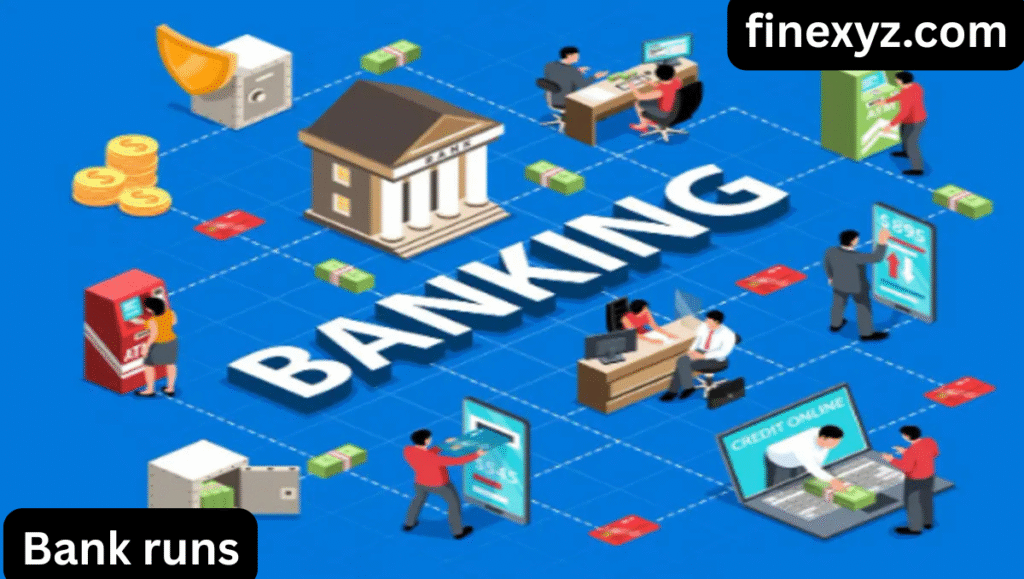When you deposit your money at a bank, you normally trust that it will be safe. You expect to be able to withdraw your money whenever you need it. However, panic can take over and cause a large number of customers to hurry to withdraw their money simultaneously. This type of event is known as a bank run.
Bank runs have happened throughout history, and they continue to occur today. They have the potential to erode public trust, generate economic stress, and possibly bring down major financial institutions. In this post, we’ll look at what a bank run is, why it occurs, the consequences, and what may be done to prevent it.
What is a bank run?
A bank run occurs when a large number of depositors visit their bank at the same time to take their money, fearing the bank will fail.
Banks normally do not hold all of their customers’ money in cash. Instead, they lease it out, invest it, or spend it on other financial activities. They simply maintain a modest amount in reserve to cover everyday withdrawals.
If too many people ask for money at the same time, the bank will be overwhelmed. Even a robust bank might swiftly run out of money during a run. This causes a chain reaction in which other consumers fear and attempt to withdraw whatever is left.
Why do bank runs occur?
Bank runs are mostly motivated by fear and a loss of trust. Here are the most typical reasons why they occur:
1: Rumors of Bank Trouble
A simple rumor about a bank being in financial problems might cause fear. People do not want to risk losing their funds, so they rush to withdraw them.
2: Economic Uncertainty
During economic downturns or crises, people may lose trust in financial institutions in general. When one bank appears unstable, anxiety spreads to others.
3: Visible Bank Struggles
Customers may be concerned if a bank discloses significant losses, delays payments, or restricts withdrawals. Even minor indicators of weakness might make people fear.
4: Psychology of Herd Behavior.
Humans frequently follow the crowd. If customers observe a line growing outside a bank, they may opt to withdraw money as well, even if they had no initial concerns.
Historical Examples of Bank Runs
Bank runs aren’t new. They have occurred throughout history, leaving lasting imprints on the financial world.
1: The Great Depression (1930s, United States)
During the Great Depression, thousands of banks failed. People lost trust in the system, and bank runs became commonplace. This time period resulted in the formation of the Federal Deposit Insurance Corporation (FDIC) in the United States to protect deposits.
2: Northern Rock (2007; UK)
In 2007, Northern Rock, a British bank, experienced liquidity issues. When customers found out about it, lengthy lineups formed outside its locations. It was the UK’s first big bank run in almost a century.
3: Silicon Valley Bank (2023, US)
Silicon Valley Bank recently failed after depositors, primarily internet companies, withdrew billions of dollars in a matter of days. Social media and online banking accelerated the spread of the run.
These examples demonstrate that bank runs can occur at any time, and that technology can accelerate their spread.

The Effects of a Bank Run
Bank runs have major ramifications not only for the bank, but for the entire economy.
1: Bank Collapse
If a bank is unable to meet withdrawal demands, it may close. This damages trust and has the potential to wipe away shareholder value.
2: Loss of savings
Without insurance or government protection, depositors risk losing their money. This is especially harmful for families and small businesses.
3: Spillover to other banks
When one bank fails, fear spreads to others. People may assume that all banks are unsafe and withdraw funds from otherwise healthy institutions.
4: Economic slowdown
Banks make loans to both businesses and individuals. When banks fail or lend more conservatively, investment, spending, and overall economic growth suffer.
5: Government Intervention
To protect the financial system, governments frequently intervene. This could include
bailouts, guarantees, or emergency loans. While this helps to stabilize the economy, it can also spark debates about equity and taxpayer responsibility.
How governments and banks prevent bank runs
Over time, countries have devised measures to prevent bank runs and restore trust. Some of the most important ones are:
1: Deposit Insurance
In many countries, governments insure bank deposits up to a certain amount. For example, in the U.S., the FDIC guarantees deposits up to $250,000 per account. This reassures people that even if the bank fails, their money is safe.
2: Central Bank Support
Central banks act as “lenders of last resort.” They can provide emergency funds to banks facing liquidity problems, preventing panic from spreading.
3: Strict Regulation
Banks must follow rules on how much capital and cash reserves they hold. These rules make them more stable and less likely to collapse.
4: Communication and Transparency
Governments and banks often use public statements to calm fears. Clear communication can stop panic before it grows.
5: Modern Technology
Today, authorities monitor financial institutions more closely with real-time data. This helps detect problems early and act before panic spreads.
Why Bank Runs Still Happen Today
Even with modern protections, bank runs still occur. Why?
- Speed of Information: Social media spreads news—both real and fake—at lightning speed. A single tweet or viral post might spark fear.
- Large Concentrations of Depositors: Some banks service very specific populations, such as startups or specialty industries. If these groups shift their money swiftly, it can drain a bank’s funds fast.
- Psychological dread: No matter how advanced technologies grow, human psychology still drives dread. People would rather be safe than sorry.
What Can You Do as a Depositor?
While governments and banks play a vital role, you can also take efforts to safeguard yourself.
1: Know Your Deposit Insurance
Be careful of the protection limit in your country. Keep your deposits inside the covered amount whenever possible.
2: Diversify Your Accounts
Instead of placing all your savings in one bank, consider distributing it around multiple banks. This decreases danger.
3: Stay Calm During News Headlines
Not every gossip is true. Before making a decision, consult credible news sources or official government announcements.
4: Keep emergency funds.
If banking services are stopped, having some cash on hand at home can help to calm the situation.
The Human Aspect of Bank Runs
Every bank run is driven by human behavior—our fear of losing what we’ve worked for. Seeing people panic often causes us to panic. This chain reaction has more to do with trust than with numbers.
When faith in financial systems erodes, it demonstrates how fragile confidence can be. Bank runs remind us that money is more than just economics. It is also about psychology. Confidence is worth as much as cash.

Conclusion
Bank runs may seem like occurrences from the past, yet they are still relevant today. Whether it’s the Great Depression, the 2007 financial catastrophe, or the recent failure of Silicon Valley Bank, the story is the same: fear spreads quicker than money.
read more
Deposit insurance, central banks, and stronger rules have made bank runs less likely to ruin entire economies. Nonetheless, they are a strong reminder of how trust and confidence affect our financial systems.
Faq’s
1. What is a bank run?
A bank run occurs when a large number of clients withdraw their money at the same time, fearing that the bank may fail.
2. Why do bank runs happen?
They are frequently the result of fear, rumors, or a lack of trust in the bank’s capacity to refund deposits.
3. Can banks withstand a bank run?
Most banks cannot since they do not keep all deposits in cash and may quickly run out of funds.
4: How are deposits secured during a bank run?
In several countries, deposit insurance protects people’s savings by covering a specific sum.
5: How can individuals avoid bank runs?
By maintaining deposits within insurance limits and spreading them across multiple institutions.
